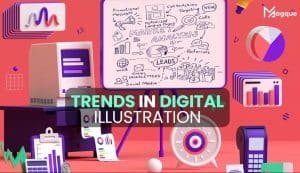Navigating the Design Landscape: Print vs Digital
Hey there, fellow designers and creative minds! Have you ever found yourself torn between designing for print and diving into the digital realm? It’s like choosing between painting on canvas or sculpting in virtual reality—both offer unique challenges and opportunities. So, let’s unravel the mysteries of designing for print versus digital and discover the key differences that set these two worlds apart.
The Tangible Touch of Print
First, let’s talk about the tactile allure of print design. There’s something magical about holding a beautifully crafted piece of print media – a glossy magazine, a crisp business card, or a stunning poster. Print design allows you to play with textures, finishes, and paper stocks, creating a sensory experience that’s impossible to replicate digitally. It’s like crafting a work of art that leaps off the page and into the hearts of your audience.
Pixel Perfect Precision in Digital Design
On the flip side, digital design offers a new dimension of creativity and interactivity. With the power of pixels at your fingertips, you can create dynamic animations, immersive websites, and interactive user experiences that engage and delight audiences in ways print can’t match. Digital design is like painting with light – every pixel is a brushstroke, and the canvas is limitless.
Print: Static vs Dynamic Digital
One of the fundamental differences between print and digital design lies in their nature – print is static, while digital is dynamic. In print, once the ink hits the paper, it’s set in stone (or paper, to be precise). Every detail must be carefully planned and executed, as there’s no going back once it’s printed. In contrast, digital design offers the flexibility to tweak and refine your creations on the fly, adapting to your audience’s ever-changing needs and preferences.
Color Spaces and Resolution Realms
Another critical difference between print and digital design is how they handle colour spaces and resolutions. In print, colours are defined using CMYK (Cyan, Magenta, Yellow, Black) colour models, while digital design typically relies on RGB (Red, Green, Blue). Additionally, print requires high-resolution images to ensure crisp, clear output, whereas digital design allows for lower resolutions optimized for web and screen display.
Join the Design Dialogue at Magque
Ready to dive deeper into the design world and explore the nuances of print versus digital? Then, join us at Magque, where we celebrate creativity, innovation, and the art of visual communication. From in-depth tutorials and tips to showcases of inspiring artwork, Magque is your ultimate destination for all things design. So grab your stylus or printmaking tools, unleash your creativity, and embark on a design adventure together!
Read Also:














